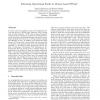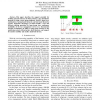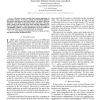105
click to vote
ICPP
2000
IEEE
15 years 4 months ago
2000
IEEE
The idle computers on a local area, campus area, or even wide area network represent a significant computational resource--one that is, however, also unreliable, heterogeneous, an...
117
Voted
FPGA
2000
ACM
15 years 4 months ago
2000
ACM
In recent years the application space of reconfigurable devices has grown to include many platforms with a strong need for fault tolerance. While these systems frequently contain ...
GECCO
2006
Springer
15 years 4 months ago
2006
Springer
In the realm of data mining, several key issues exists in the traditional classification algorithms, such as low readability, large rule number, and low accuracy with information ...
90
Voted
FDTC
2006
Springer
15 years 4 months ago
2006
Springer
We present a new approach to fault tolerant public key cryptography based on redundant arithmetic in finite rings. Redundancy is achieved by embedding non-redundant field or ring ...
127
Voted
EDCC
2006
Springer
15 years 4 months ago
2006
Springer
The importance of fault tolerance at the processor architecture level has been made increasingly important due to rapid advancements in the design and usage of high performance de...
105
Voted
DSN
2004
IEEE
15 years 4 months ago
2004
IEEE
Some safety-critical distributed embedded systems may need to use centralized components to achieve certain dependability properties. The difficulty in combining centralized and d...
73
Voted
DSN
2004
IEEE
15 years 4 months ago
2004
IEEE
This paper describes the support provided for mobility and fault tolerance in Mykil, which is a key distribution protocol for large, secure group multicast. Mykil is based on a com...
114
Voted
DSN
2004
IEEE
15 years 4 months ago
2004
IEEE
Recent developments in the field of object-based fault tolerance and the advent of the first OMG FTCORBA compliant middleware raise new requirements for the design process of dist...
110
Voted
DEXAW
2004
IEEE
15 years 4 months ago
2004
IEEE
To achieve correct execution of peer-to-peer applications on non-reliable resources, we present a portable and distributed algorithm that provides fault tolerance and result checki...
ASAP
2006
IEEE
15 years 4 months ago
2006
IEEE
A popular approach to guarantee fault tolerance in safety-critical applications is to run the application on two processors. A checkpoint is inserted at the completion of the prim...



